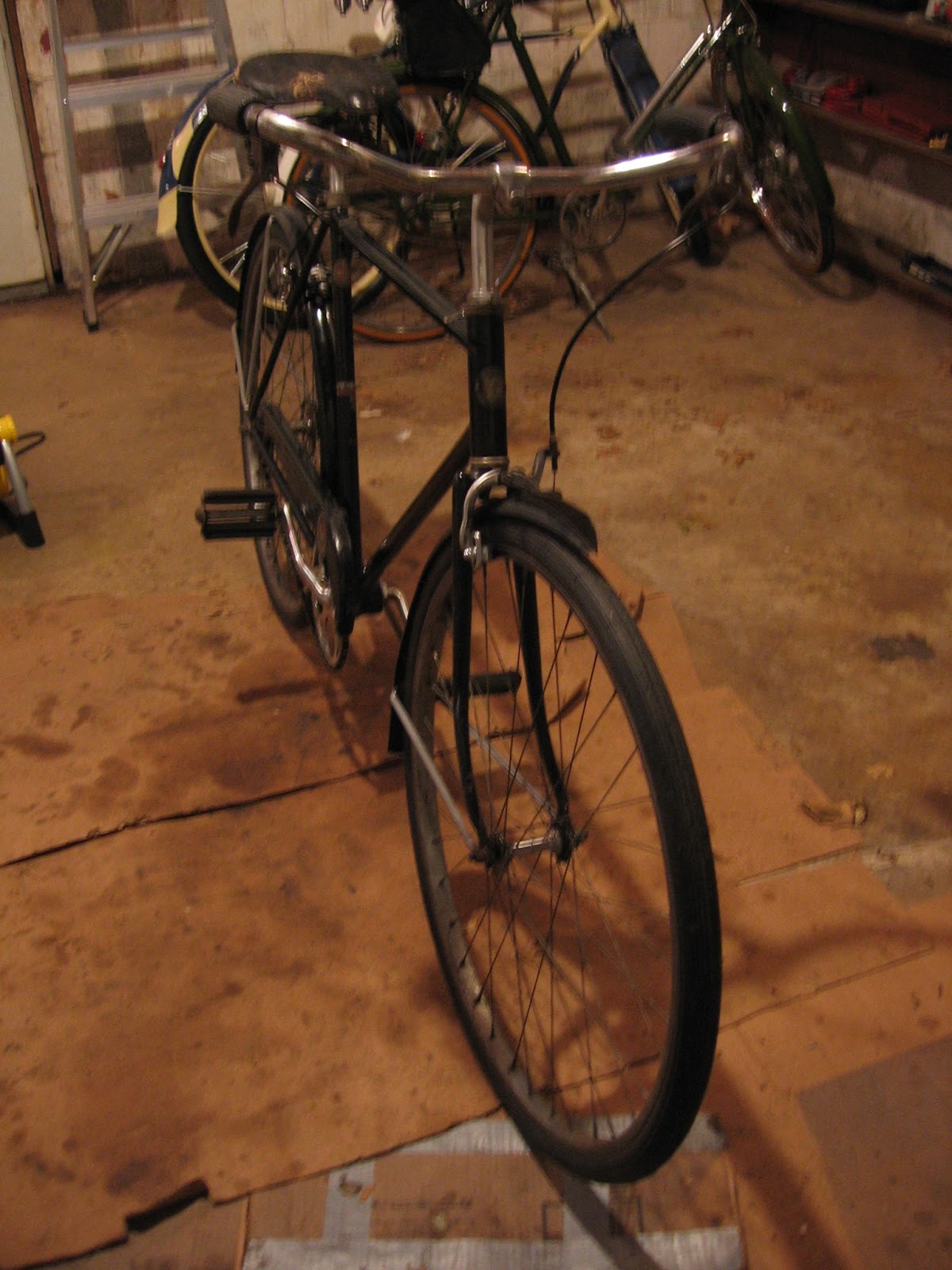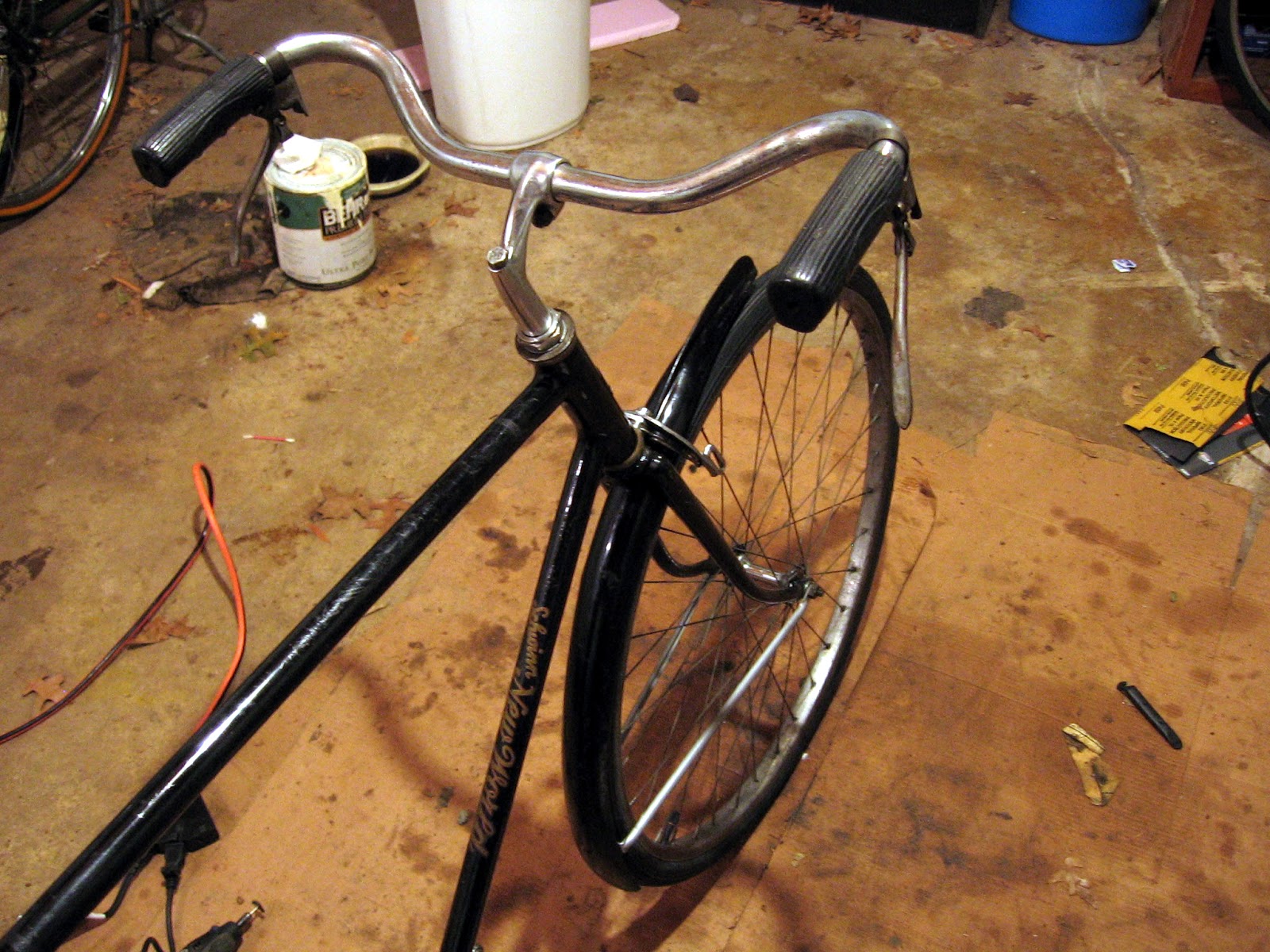It was warm this weekend here, so I got quite a bit done on the New World project. Normally it's in the upper 30s this time of year, but both days this weekend were around 50. There's been plenty of winter up north, where I was on vacation. Now down here in Virginia, there's been no real winter... so far.
I. Polishing A Bicycle Frame
The first thing I did was to bring the bike and parts outside into the (relatively) warm sun. I used Scratch Doctor brand car polish to polish up the frame. I basically follow the directions.
1. Rub on the polish to form a film and let it sit a couple minutes.
2. Take a clean, soft cloth and buff the frame until the desired shine is achieved.
This also was beneficial because it allowed me to see where I needed to clean up the paint further, or apply patches of matching touch-up. Polishing first also allowed me to see what the final finish would look like on the frame, so I could better match the paint if I needed to touch up anywhere.
II. Bottom bracket rebuild:
I also put the bottom bracket back together.
1. Apply grease to the bearings, cups and cones. I used a dark lithium grease, which is my grease of choice because it stays soft in cold conditions and stays loose without becoming sticky or heavy like traditional axle grease.
2. Re-assemble in the opposite manner that you disassembled it. If you recall from my earlier entry on bottom brackets, I used a string loop to help keep the pieces in order.
II. Bicycle Fender Touch-Up
A. Fender Wells and Preventing Fender Rust
Previously, I had soaked fenders in oxalic acid and used a Dremel wire brush to remove rust and clean up bare spots. Then, I used polish to clean up the fenders, using the method I did above on the frame.
I started with the insides of the fenders. The insides of the fenders are low visibility, but they are a hot spot for rust. In this case, I decided to coat the insides of the fenders with thinned mixture of enamel paint. The way I did this was to match the paint (Semi-gloss black matched), then thinned the paint with a little thinner. I used probably 4 parts paint to 1 part thinner. I then soaked a wedge sponge brush-type tool and coated the insides of the fenders.
The thinned paint seeks its own level, much like water, so filled in the low spots and bare spots in the fender well. This creates a barrier against moisture and future rusting. Remember, these wells often see moisture from puddles and just riding around, so you need a coating in those bare spots. Once dry, the product is presentable, but also a nice barrier against rust and further corrosion. In the picture below you can see the coating. The light spots you see are dust.
B. Fender Exterior
The fender exterior is obviously tougher. You need to both prevent rust and blend with the existing paint. There are a couple of options:
i. Remove the rust and rub with oil/WD40 every so often. This is the relic approach and is best for bikes where you don't want to put on any paint. Uncommon bikes in original condition probably fall here. I wouldn't put any paint on a rare or very valuable bicycle, but obviously you have to get active rust off and keep moisture out of bare metal spots.
ii. Remove the rust, then match the paint and fill in bare spots. This is what I did on the New World bicycle. The bike has some value, but it not particularly rare or highly valuable. Again, I used a thinned mix of paint. I took gloss black, thinned 1 part thinner to 3 or 4 parts paint (a little improvising there) and used a very small brush to dab the paint into the low spots. Once again, the thinner in the paint allowed it to drop in and level in the low parts because of it had better viscosity than thicker paint.
However, before I could do that I discovered the rivets holding the fork mounting bracket to the fender were damaged beyond tightening or repair. I drilled and punched them out, the replaced with riv-nuts. I then paint matched the riv-nuts to the rest of the finish. The results are below.
As you may recall, the fender braces were bare. They had no Cad plating left on them and were rusted. I used bronze wool and a Dremel wire brush to remove the rest of the rust. I then made up a "Cad-type wash". This basically is thinned chrome paint applied to a rag and rubbed in to match cad plating. In this case, I wanted to simulate aged cad plating, which is silver but somewhat flat compared to new cad or to chrome.
1. Dipped a soft rag in paint to partially soak with thinner.
2. Spray Chrome paint onto the rag until that same spot that had the thinner takes on the paint and it mixes with the thinner in the fiber.
3. Rub and improvise until it looks right
The results are mixed. It is not as perfect as nice, aged Cad plating, but it beats letting the metal rust and it beats plain silver hobby paint. The silver finish is a little strong right now, but I'll come back after a week or so with a dry rag and "wear" the finish so that it looks like aged Cad. So far, it looks like the picture below, but once "aged" a little more, it will match nicely.
III. Regreasing a Bicycle Headset
1. Disassemble the headset
Old bicycles have pretty simple headsets. You remove the upper nut and the fixed spacer, then unscrew the head set ring. This ring is attached to threads on the fork shaft, allowing the fork to be removed from the bike. Beware that inside those silver cups on the frame are two sets of ball bearings. Some bicycles have loose balls, and some have ball cages. This 1947 Schwinn New World has small cages.
2. Cleaning
The fork will now drop out of the frame. Make sure not to damage the headset bearings. Now, take some de-greaser (I used 409) and a tooth brush. Brush off the old grease until clean. Also inspect the fork shaft for damage or corrosion. I used a Dremel wire brush to remove some rust from this fork shaft. Fortunately, the rust was superficial and there was no pitting. The fork shaft often will also allow you to see the original primer and paint colors of a bicycle. Most amateur re-paint spray jobs miss this spot. In this case, we have classic Schwinn red primer and black paint.
As you can see, there is a silver bearing race cone on the fork. This is a vital part of the steering, so check it for damage. You should really give it a good cleaning.
Also clean the balls/cages. These are small cages, as seen below. They are marked "Hartford" and are made in the USA. They are most likely original.
Also clean the upper cone and, again, check for damage. It is shown below.
3. Re-grease and assemble
As I mentioned above, I like dark lithium grease. It's thinner and doesn't gum up like traditional axle grease, but it not so thin it runs out all over. I really like to give a good coating. Apply the grease to the cups, cones, and bearings. Re-assemble in the reverse of how you disassembled. Again, be careful not to pinch the bearings or cross-thread the upper cone. Those threads are REALLY fine, so be careful. Some people also apply a little graphite anti-seizure compound (Choke Tube Lube, for example; NOT Loc-Tite) to the fine threads.
Well that was quite a bit of work. Much was done and the project is well on the way.





















































